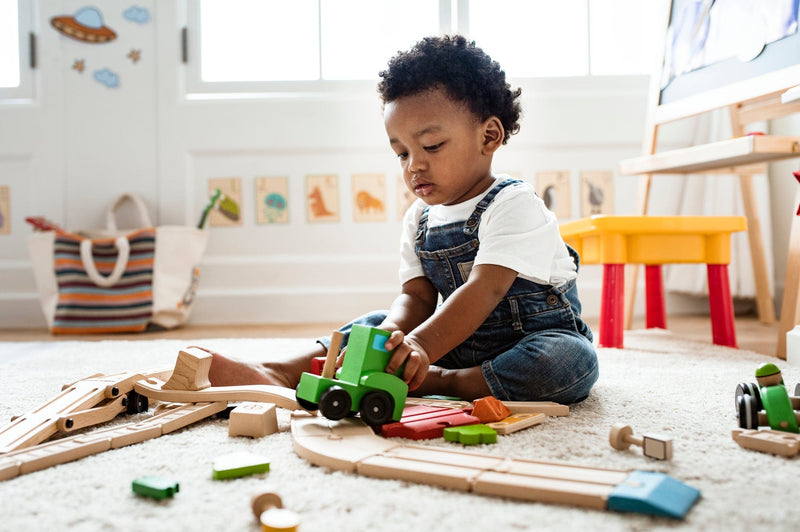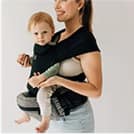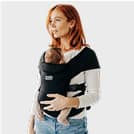Are Baby Carriers Really Safe for Baby Hips?
Written by Connor Bringas on January 13, 2022.
When it comes to baby carriers, there are so many options out there — from slings to backpacks to wraps, each carrier carries it’s own questions. Which baby carriers are the best? When can you start using them? Are baby carriers good for baby hips?
Some carriers are best suited for different stages of your baby’s life depending on their age and developmental stage, but the right carrier is out there! And at any age, hip health can be a concern, so it’s important to consider your baby’s age, weight, and your own lifestyle when choosing a baby carrier.
Do your research, talk to other parents, or consult your pediatrician if you’re just not sure where to start. In the meantime, we answered some of our customer’s questions about baby carriers and hip health below:
How long can a baby stay in a carrier?
There are no hard and fast rules about how long your baby can stay in their carrier, and the amount of time will likely change as they grow. However, it’s always important to take into account their age and the type of carrier you’re using. Some experts suggest that babywearing should be limited to 2-hour stretches, as some carriers may restrict baby’s hips and legs when used for too long.
Are baby carriers comfortable for babies?
Yes! Some of the softer, less structured carriers mimic the womb in those early months of life, which help babies make that “4th trimester” transition. They also may help soothe a baby who is fussy or going through a growth spurt. Carriers also work great for parents who want to be “attached” to their babies without having to use their hands and arms to hold them constantly.
Tons of parents swear by babywearing when their baby is younger, before they become more aware and curious about the world around them. At that age — around 4-6 months or so — they can switch to a hip seat carrier. Hip seats allow for more independence as your baby grows and develops, and they’re great for those easy pick up, put down, and pick up again moments.
Are baby carriers safe for baby hips?
When it comes to baby hips and baby carriers, carriers that promote a “super-quat” M-position to reduce the risk of hip dysplasia. According to the International Hip Dysplasia Institute, “when proper hip position is maintained while babywearing, there may be substantial benefit for natural hip development.” This means that your baby’s hips should not be restricted while babywearing, and their legs should be able to move freely and not be straight or together for long periods of time. Some carriers are more supportively designed with baby hip health taken into consideration.
While babywearing, it’s also a good idea to adjust your baby’s legs and hips every so often to make sure they’re in the optimal hip healthy position — knees sitting higher than their tush.
Are baby carriers bad for baby hips?
Baby carriers aren’t necessarily bad for a baby’s hips, but it’s important to follow the manufacturer’s directions and safety guidelines to guarantee proper use. Better yet, check out their website to see if there’s a video or downloadable instructions to really ensure you’re wearing the carrier properly.
Remember, as fun as it is to wear your baby, they also need to use their senses to explore the world around them. So enjoy all of the benefits that carriers have to offer, and then enjoy some tummy time to strengthen your baby’s neck and shoulder muscles, and improve their motor skills.
Can you use baby carriers with hip dysplasia?
In the simplest of terms, hip dysplasia essentially means a dislocated hip. This can happen for a variety of reasons, but keep in mind that while a diagnosis of hip dysplasia sounds utterly terrifying, it is a common diagnosis among newborns and is highly treatable. Because hip dysplasia isn’t usually identified until your baby is walking, it may be hard to detect when your baby is still an infant. That’s why it’s important to make sure that your baby is in the correct M-position while babywearing. This will promote hip-healthy growth.
Are hip seat baby carriers safe for baby hips?
Hipseats are safe for baby hips as long as you follow directions. With the Tushbaby hip carrier, your baby’s tush is supported by an supportively designed padded seat that allows baby’s hips to spread so their legs are straddling your body. Your baby’s knees are apart, their thighs are supported, and their posture resembles that of an “M”.
Is a baby carrier with hip seat good?
Carrying around your baby should be comfortable for everyone! That’s why experts suggest that when choosing a baby carrier, finding one with proper support is essential for both the baby and the baby wearer. A baby carrier with a good hip seat allows for healthy hip positioning for baby — that means seated tush, hips spread and thighs supported.
What are the best baby carriers for hip support?
The Tushbaby hip seat carrier is designed with your back and your baby in mind. Tushbaby encourages the “M” shape posture, which allows for a straighter spine for your baby and keeps their hips in a healthy position. This is offered through the wide seat base, which keeps your baby’s legs supported and lifted rather than dangling or hanging. Worn high and tight above the hips, Tushbaby alleviates pressure on your back and shoulders so you can carry your little one longer and more comfortably.








Leave a comment